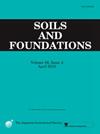基于有效应力分析的复垦土液化响应
IF 3.3
2区 工程技术
Q2 ENGINEERING, GEOLOGICAL
引用次数: 0
摘要
对新西兰惠灵顿港(CentrePort)的剖面进行了一维动态有效应力响应分析(ESA),该剖面包含由砾石-沙子-淤泥(G-S-S)混合物和水力填充物组成的填海填充物。研究的第一阶段在考虑PM4Sand和应力-密度本构模型建模不确定性的情况下,实际模拟了最近三次地震的历史。研究结果通过对G-S-S填充物响应的细致工程解释,阐明了解释液化表现的严重程度和土壤喷射特征的可能机制。对于水力充填体,1D ESA在解释受充填体组成和响应特性二维变化影响的复杂表现模式方面面临挑战。在分析的第二阶段,提出了基于esa的响应措施,以量化一系列输入地震需求下液化响应的严重程度。在不同的输入地震动范围和两种土本构模型下,响应特性的离散性很小。结果表明,ESA能够捕捉液化响应的细节,如松散沉积填筑体液化触发的阈值地震烈度相似,反映填筑体厚度差异的不同地点的最大响应,以及反映沉积特征差异的响应从触发到最大的演变过程。本文章由计算机程序翻译,如有差异,请以英文原文为准。
Liquefaction response of reclaimed soils from effective stress analysis
One-dimensional (1D) dynamic effective stress site response analysis (ESA) is performed for profiles at the port of Wellington, New Zealand (CentrePort), which contains reclamation fills comprised of gravel-sand-silt (G-S-S) mixtures and hydraulic fills. The first phase of the study realistically simulates three recent earthquake case histories while considering modelling uncertainties by using the PM4Sand and the Stress-Density constitutive models. The results illustrate possible mechanisms explaining the severity of liquefaction manifestation and soil ejecta characteristics observed in G-S-S fills through careful engineering interpretation of the response. Challenges for 1D ESA to explain complex manifestation patterns affected by two-dimensional variability in fill composition and response characteristics are illustrated for the hydraulic fills. In the second phase of analyses, ESA-based response measures are proposed to quantify the severity of the liquefaction response for a range of input seismic demands. The response characteristics show very small scatter despite using a range of different input ground motions and two soil constitutive models. Results illustrate the capability of ESA to capture details of the liquefaction response such as the similar threshold seismic intensity for liquefaction triggering of the loosely deposited fills, different maximum response of the sites reflecting the differences in the thicknesses of the fills, and the evolution of the response from triggering to maximum reflecting differences in depositional characteristics.
求助全文
通过发布文献求助,成功后即可免费获取论文全文。
去求助
来源期刊

Soils and Foundations
工程技术-地球科学综合
CiteScore
6.40
自引率
8.10%
发文量
99
审稿时长
5 months
期刊介绍:
Soils and Foundations is one of the leading journals in the field of soil mechanics and geotechnical engineering. It is the official journal of the Japanese Geotechnical Society (JGS)., The journal publishes a variety of original research paper, technical reports, technical notes, as well as the state-of-the-art reports upon invitation by the Editor, in the fields of soil and rock mechanics, geotechnical engineering, and environmental geotechnics. Since the publication of Volume 1, No.1 issue in June 1960, Soils and Foundations will celebrate the 60th anniversary in the year of 2020.
Soils and Foundations welcomes theoretical as well as practical work associated with the aforementioned field(s). Case studies that describe the original and interdisciplinary work applicable to geotechnical engineering are particularly encouraged. Discussions to each of the published articles are also welcomed in order to provide an avenue in which opinions of peers may be fed back or exchanged. In providing latest expertise on a specific topic, one issue out of six per year on average was allocated to include selected papers from the International Symposia which were held in Japan as well as overseas.
 求助内容:
求助内容: 应助结果提醒方式:
应助结果提醒方式:


